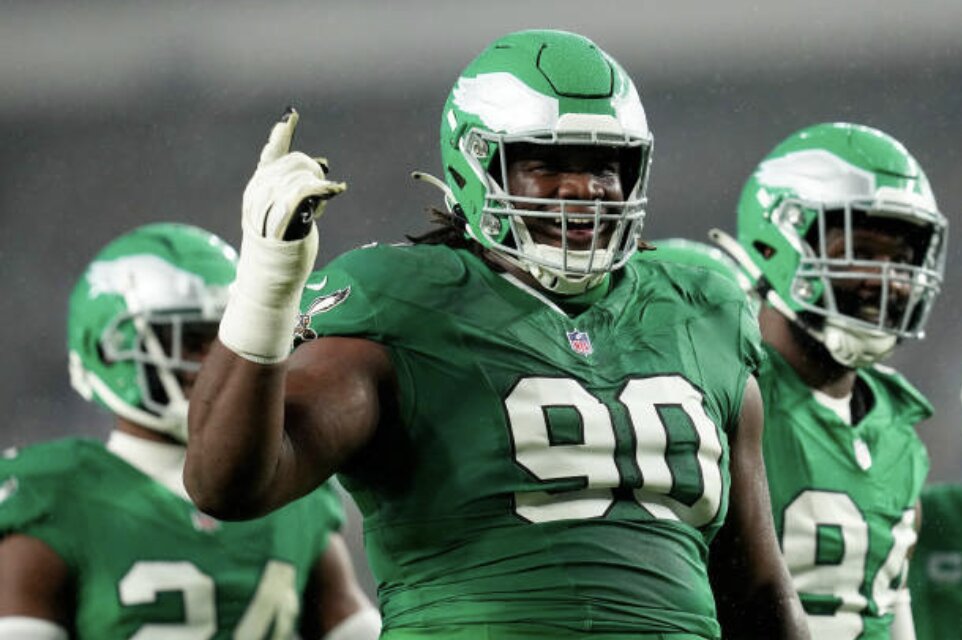Here’s The Catch: Young Birds WRs Have High Upside, But…
As second-year Eagles wide receivers coach Aaron Moorehead prepares for the unenviable task of configuring how each player fits into the equation, he remains optimistic about the positional outlook.
“Going from Year 1 to Year 2 and Year 2 to Year 3, those are always the biggest jumps, in my mind, as far as players go,” Moorehead said on Tuesday Zoom call with reporters. “From my group, basically everybody is going from one of those two places.”
Though Moorehead expressed high hopes for the future, his oft-scrutinized position will be viewed under a microscope this summer, as last season yielded a mixed bag of production from the group in which he presided over.
The room is undoubtedly young and brimming with upside, but Moorehead’s confidence can only be fulfilled by the progression of a pair of polarizing pass catchers.
When the Eagles selected Jalen Reagor with the 21st overall pick in the 2020 NFL Draft ahead of Justin Jefferson – to the dismay of many – the TCU standout was billed as a versatile chess piece with explosive traits and a dynamic in-space weapon.
In his NFL debut, Reagor established a downfield presence, reeling in a 55-yard heave from Carson Wentz on his lone reception. He then snagged four more receptions for 41 yards the following week, only to land on Injured Reserve due to a ligament injury in his thumb.

Expectations are greater for Jalen Reagor in Year 2 after an injury plagued rookie season.
He returned to the lineup in time for a home showdown against the NFC East rival Dallas Cowboys on Nov. 1 and came away with his first professional touchdown but wouldn’t eclipse the 52-yard receiving mark for the rest of the season.
While Reagor’s utilization was both unimaginative and puzzling, his insufficient route-running, missed opportunities, vulnerability to outside criticism, and poor body language also played a vital role in his underwhelming rookie campaign.
If this year’s offense is to thrive, however, Reagor must be a prominent ingredient to the concoction. His blazing speed and big-play potential furnish a relatively vanilla aerial attack with a vertical dimension.
With last season all but a distant memory, Reagor has hit the ground running in Year 2, and his newfound approach isn’t lost on Moorehead.
“I think he’s calmer,” Moorehead said. “He’s just letting his play speak for himself. He’s always been a good worker. He’s got a lot of talent, we know that. He’s just doing the things he needs to do to better himself, and I think that’s really important to understand that you have enough talent to be a really, really good player in this league. And you don’t have to listen to anyone else other than the people in this building, and your family structure at home, and let’s go play ball. He’s been very diligent about that, and I think it’s shown in his preparation.”

Travis Fulgham must prove his four-week success last year wasn’t a fluke.
As crucial as Reagor is to the offense’s functionality, the X-factor for this receiving corps is third-year pro Travis Fulgham.
When the Eagles were awarded Fulgham off of waivers last August, following his nine-day stint with the Green Bay Packers, it was widely viewed as a mere footnote – fresh legs to eat up snaps amid the dog days of summer. The Eagles were Fulgham’s third team just that month.
Despite being perhaps the longest of long shots, given his abbreviated audition to nail down the playbook and dazzle the coaching staff, the 6-foot-2, 215-pound receiver made enough plays to stick around on the practice squad and turn some heads.
Four weeks later, a promotion to the active roster incredulously thrust the former sixth-round pick into the prime time spotlight, even more so after he hauled in an acrobatic, 42-yard touchdown in a narrow victory over the San Francisco 49ers on Sunday Night Football.
For the next four weeks, Fulgham served as the team’s de facto top wide receiver, accumulating 41 receptions for 378 yards and three touchdowns. It appeared the Eagles had unearthed a gem and long-term starter on the perimeter.
However, Fulgham’s flame was extinguished just as quickly as it ignited. He combined for just nine catches for 104 yards the rest of the way. Though Moorehead witnessed the disappearing act first hand, he recognized both the potential and the growing pains in his young wideout.
“The four weeks showed me a lot and showed everybody a lot,” Moorehead said. “With that, it also comes with the responsibility of understanding that now defenses are gonna start scheming towards you to stop you. That, for a young player, him understanding that it took a little bit. Then, he got nicked up a little bit and didn’t complain, but he had to play through it. As the season got going, it wore on him a little bit.”
How could a player who appeared dominant at times – at a position of need, nonetheless – fall out of favor so drastically?
Listening to Moorehead describe it through vague innuendo, Fulgham fell victim to complacency and inconsistency in practice.
While those are common for a young player who has a sudden brush with success, when also combined with playing through a nagging injury and adjusting to new defensive attacks, Fulgham simply became a non-entity by season’s end. It appeared he’d hit the proverbial wall.
While those are certainly valid reasons for a drop-off in production, the phase-out began in Week 10 – when Alshon Jeffery returned to the lineup. It felt all-too-coincidental.
Jeffery, also a big-bodied pass-catcher, provided virtually nothing to the offense. The lumbering wideout racked up just 13 catches for 115 yards and one touchdown despite compiling 202 snaps over the final seven games. It appeared Jeffery was being shoe-horned into the offense, which, in turn, stunted Fulgham’s progression. Rather than allow Fulgham to fight through the adversity, he was banished to the sidelines.
Moorehead, however, dismissed the parallels.
“I don’t, Moorehead said. “It was impeccable timing, to say the least. I’ve always been a guy where, the best guy is gonna play. I don’t care if it’s Travis Fulgham who showed up here in the last week of training camp and started playing, or Alshon, or any other guy. It was the best guy was gonna play.”
Whatever the reason, an extreme regression is cause for concern. But by the same token, a wide receiver doesn’t accrue those stats, in that matter, against those secondaries, just by accident.
Fulgham’s output was no flash in the pan or stoke of luck but the result a young player who essentially became an overnight sensation and, for various reasons, wasn’t able to sustain his success.
Fulgham’s size, catch radius, ability to high-point and win in contested-catch situations – on an undersized receiving corps – will be paramount to unlocking the red-zone efficiency and intermediate passing game.
If Fulgham can return to form, and if Reagor evolves into the game-breaking mismatch he was drafted to be, Moorehead will have found his answers to the equation.
– Andrew DiCecco (@ADiCeccoNFL) is a Staff Reporter/Content Producer for InsideTheBirds.com.






Comments are closed here.